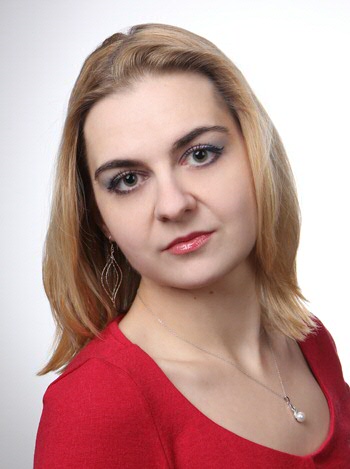New assistant professor in our team - Jagoda Sławińska
The University of Groningen has for a long time been among the top influencers globally in spintronics research. The reputation of the Zernike Institute for Advanced Materials has continued to attract the best talent, and recent years have seen some promising research in the spintronics field.

A newcomer preparing for her start at the institute in September, Jagoda Sławińska is an assistant professor with experience in spintronics and two-dimensional materials and a rare hands-on approach to research.
Although Sławińska has “plans for purely theoretical research,” she is also keen to “work very closely with experimentalists” in her new role.
“My areas of interest are novel materials for spintronics and novel phenomena related to spin-orbit physics, taken in strong connection with low-dimensional systems and 2D materials,” she added.
Spin-orbitronics’ potential
Although there hasn't been a major breakthrough in the research of spin transistors in more than two decades, recent studies have shown that they could be used in logic-in-memory (LIM) applications. This architecture, popularised among others by researchers at the chipmaker Intel, may bring a significant performance boost to future CPUs.
As the name suggests, the main goal of LIM is to enable computational operations within a memory array, thereby reducing the time required to access the conventional memory and improving the energy efficiency of the system.
In 2018, researchers at Intel published a paper describing a magneto-electric spin-orbit (MESO) logic device with the potential to decrease the voltage required by 80 percent and overall energy consumption by as much as 97 percent compared to conventional complementary metal-oxide-semiconductors (CMOS).
This breakthrough inspired Sławińska to engage further with the topic and this research direction is now one of her main areas of interest. Her focus now is on exploring the applications of multiferroics and spin-orbit related phenomena with LIM arrays and seeking out the best materials to use in these devices.
Closer collaboration
Sławińska is also excited by the potential industrial applications of 2D materials — namely, heterostructures and hybrid systems — related to memories and novel computing architectures. She is currently researching methods of designing a new material with the properties needed for such applications through the stacking of different layers of atomically thin materials.
Sławińska plans to continue working on this topic in Groningen “as there are groups working on similar problems.”
“We want to study 2D materials, including stacks of transition metal dichalcogenides (TMDC) that are broadly investigated in Groningen — but then I also want to go beyond that,” she said.
Sławińska has emphasized the strength of experimentalist groups at the Zernike Institute for Advanced Materials and their rich experience in growing 2D material layers. A researcher with a strong hands-on approach, she has become a major proponent of close collaboration between the theoretical and practical sides of academia and is always interested in industrial applications of her research.
“Often in theoretical papers, you'd find statements like ‘it can be useful for spintronics applications,’” she added. “This is a general statement. […] What's different about me in this sense is that I have papers that are looking solely at new devices. The main goal of one of my recent papers was to describe and demonstrate that a specific device could be constructed and work.
“This is not common for a theoretician — and of course, it's also very risky; you can propose many things but it's hard to demonstrate that they will work. However, I still think that theorists can work more closely with experimentalists, with the industry. We can still contribute to the construction of some new devices. Maybe not in detail — but in general by proposing new phenomena and the ways of connecting several different effects to get specific functionality.”
Sławińska is also no stranger to coding her way through complicated computations.
“I normally get involved in software development if I need to solve a particular problem,” she explained. “So, my group won't be development-oriented — but I am looking for students who are prepared to code. If you need to measure something in an experiment, and that measurement is not implemented in any of the known libraries, then it's important that you can write your own module to do it.”
“I'm used to working fast”
Sławińska obtained her PhD degree at the Department of Solid State Physics of the University of Łódź in Poland before working at the Spanish and Italian National Research Councils. Her latest postdoctoral position since April 2018 was in the Department of Physics at the University of North Texas. Her working experience of a wide range of institutions allows Sławińska to compare how the academic ecosystems function across the world.
“Generally, in the US the research-bound money is more mobile,” she explained. “Sure, you pay more to attend conferences and so on, but at the same time, people are more active. I've been involved in more meetings and collaborations here; it's an environment that's not inert.”
Now the researcher plans to use her international experience to embrace the best practices she has been exposed to over the years.
“For example, I believe that in the US people in and around academia act faster than elsewhere,” she said. “Now, I'm used to working fast too.”
| Last modified: | 07 August 2020 3.03 p.m. |
More news
-
24 March 2025
UG 28th in World's Most International Universities 2025 rankings
The University of Groningen has been ranked 28th in the World's Most International Universities 2025 by Times Higher Education. With this, the UG leaves behind institutions such as MIT and Harvard. The 28th place marks an increase of five places: in...
-
05 March 2025
Women in Science
The UG celebrates International Women’s Day with a special photo series: Women in Science.
-
16 December 2024
Jouke de Vries: ‘The University will have to be flexible’
2024 was a festive year for the University of Groningen. In this podcast, Jouke de Vries, the chair of the Executive Board, looks back.
